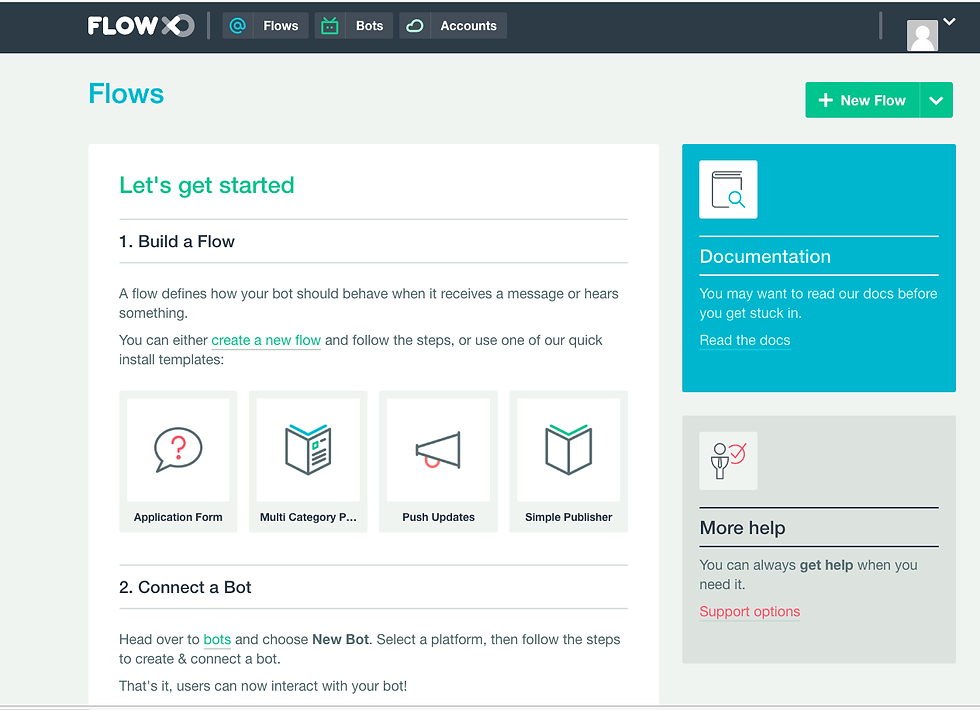Marketers: Here are a dozen authoring tools to help you get chatty with chatbots
- Fahad H

- Sep 19, 2016
- 4 min read

In case you didn’t get the memo, marketers now have another channel to wrangle: continuous, intelligent conversations with customers.
One of the most common outlets for those conversations is the increasingly popular chatbot, in messaging apps, websites, and other venues.
To help you build and maintain chatbots, we’re highlighting a dozen of the most prominent tools, many of which have just emerged in the last few months. All have graphical interfaces, and most require no programming. You just need to supply the wit:
Botsify For: Facebook Messenger

Pakistan-based Botsify sees itself as a competitor to Chatfuel, one of the most popular no-programming chat builders. (See below.) Botsify says you can set up your bot in five minutes, with message scheduling and analytics included. It’s free for unlimited messages; pricing plans begin when you integrate with other platforms and services.
Chatfuel For: Facebook Messenger, Telegram

This basic tool, which also does not require programming, is one of the most popular. It offers a free level, can be integrated with outside services, and is focused on Facebook Messenger, although it also supports Telegram. Compared to Botsify’s claims that you can create a chatbot in five minutes, Chatfuel says its tool requires seven minutes. Free until you hit certain levels of use. Backed by Yandex, the Google-equivalent in Russia.
Chatsuite For: Facebook Messenger, Kik. Coming soon: support for Viber, iMessage, Slack, Telegram, and Skype, followed by Line and WeChat.

Formerly called BetterBrand, Chatsuite describes itself as “the chat marketing platform.” Targeted at agencies, marketers, and publishers, it’s not completely self-service. The company provides training, as well a managed service to set up the basic interactive flow, while the agency provides the content and administration.
Converse.ai For: Facebook Messenger, Twitter, SMS, Slack, Intercom, Layer, and Smooch

Converse also offers a graphical user interface with no coding required, and a free level. The company says it differs by offering intelligent user engagement via user feedback like surveys, as well as support for customer service and routing, context awareness, and payment processing via Stripe.
Flow XO For: Facebook Messenger, Slack, Twilio SMS and Telegram

Also a visual bot builder that does not require programming, Flow XO is specifically targeted at sales and marketing applications. Chatbots created with Flow XO can collect data via forms and surveys or send push notifications, and the platform is integrated with nearly a hundred applications and services. There’s an initial free level, with pricing based on support, number of bots, and higher levels of interaction.
Imperson For: Facebook Messenger, Skype, Kik, Slack, Twitter, Amazon Echo, and SMS

Known for character-based sales/marketing chatbots like ones for Miss Piggy or Doc Brown (from “Back to the Future”), the Israel-based Imperson now offers a self-service enterprise platform called Imperson.ai. While users do not need to write code, they do need to undertake training from Imperson to create bots with “intent, relationship memory, personality, and natural learning capabilities.”
Kore For: Facebook Messenger, SMS, Slack, websites, email, and Kore Messaging

Kore’s Enterprise-targeted bot builder is designed for “the most complex bot use cases.” Although intended for both marketers and developers, the company says its bots can be built without coding. It offers industry-specific bots for banking and, soon, retail, and it provides over 130 bots in its store. There’s a free entry level, with additional tiers based on task definitions, storage, analytics, and other features.
Massively For: Amazon Echo, Slack, Line, WeChat, SMS, Twitter, Facebook Messenger, Skype, Kik

This do-it-yourself tool from the Toronto-based Massively also requires no programming, has a free entry level, and, as befits the name, is designed for deployment and analytics “on a massive scale.” Bots created on this platform have been used in campaigns for Teenage Mutant Ninja Turtles and Maze Runner movies, among other marketing efforts, and the company also offers a managed service.
Motion AI For: Facebook Messenger, Slack, SMS, web sites, email

Another visual chat builder that doesn’t require programming, and that offers a free introductory level, Motion AI’s tag line is: “If you can draw a flowchart, you can create a chatbot.” It features reusable modules that contain logic for specific functions, like customer service responses. It also is designed for integration with a variety of other platforms and services, from workflow integrator Zapier to customer service platform Zendesk, and the company will soon be opening a bot store.
PullString For: Facebook Messenger
Formerly called ToyTalk, PullString’s name references the string pulled on some dolls to get them to talk (e.g., Woody the cowboy doll in “Toy Story”). In fact, CEO Oren Jacob had previously been CTO at Pixar, the studio that created “Toy Story.” Accordingly, it emphasizes conversations with characters. The company’s tagline: “If you can write, you can make a bot.” Currently, PullString offers invite-only access, but the company says general availability is coming later this month.
Reply.ai For: Facebook Messenger, Kik, Telegram, Line, and SMS

This programming-less visual bot builder for enterprises touts its analytics, backend integration with platforms like Zendesk, and ability to deploy one bot to multiple platforms by adapting conversations to each platform’s user interface. It is also designed to accommodate human takeover of conversations when needed. Currently, the company is working only with selected clients, but says the platform will be open to the public in November.
Sequel For: Facebook Messenger, Telegram and Kik

This bot builder from mobile entertainment company Kiwi also requires no programming, and its focus is on entertainment and gaming bots. It offers pre-built templates, such as ones for journalists or celebrities, as well as a GameBot template for building an interactive quiz or story-based game. Like other chatbot platforms, it emphasizes the ability for a creator to build once and then deploy to multiple platforms.








Comments